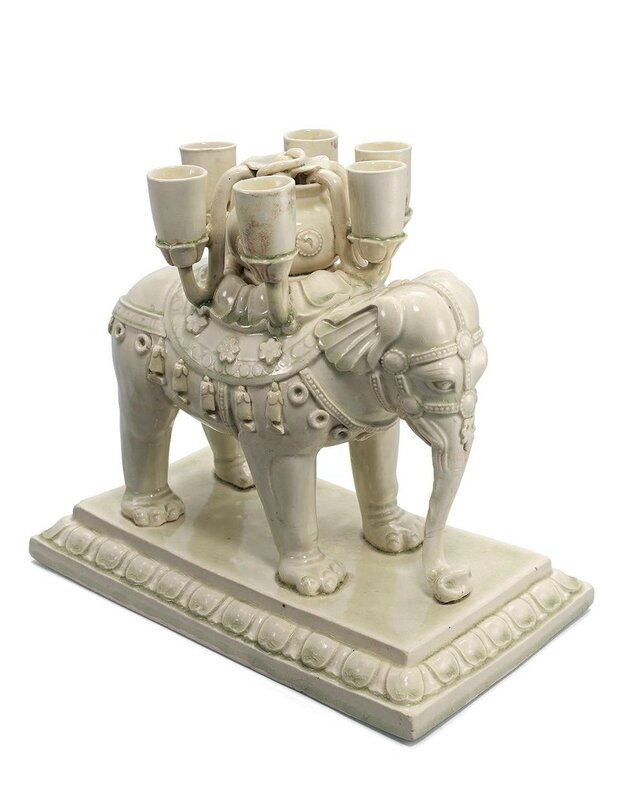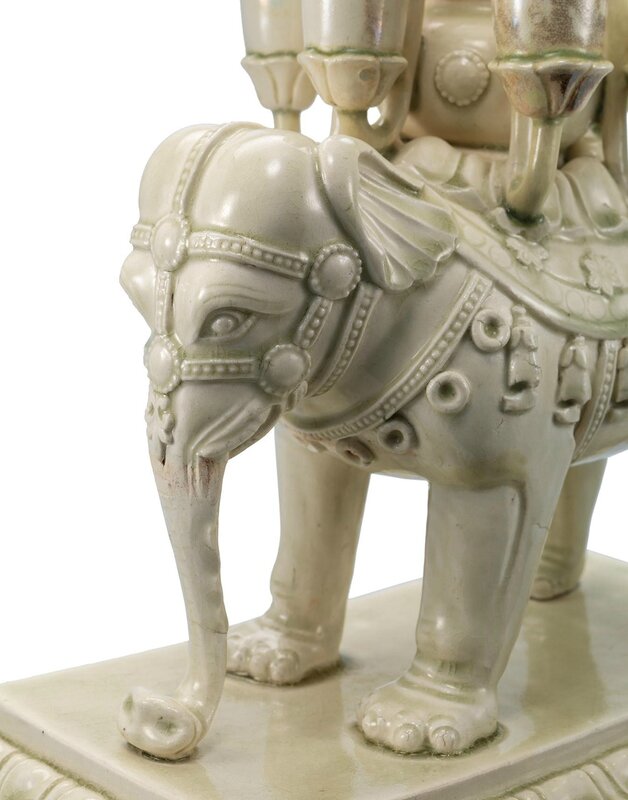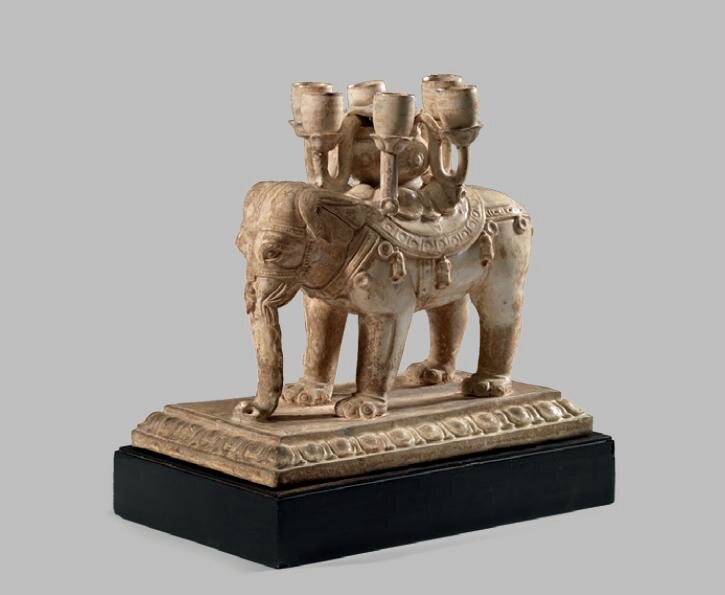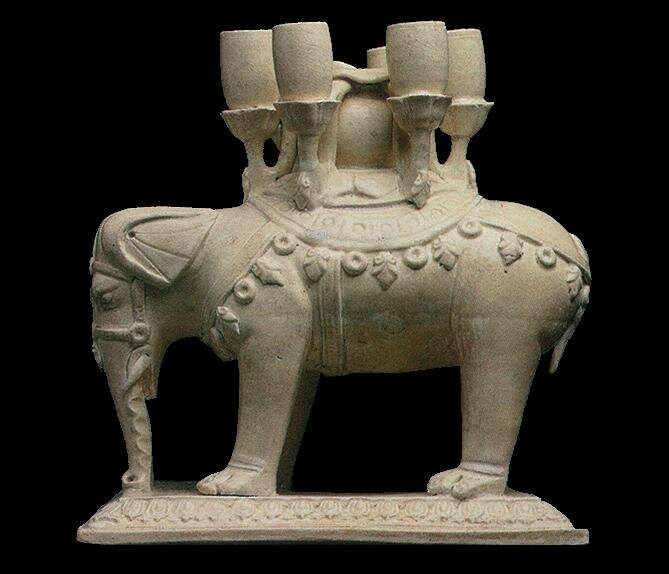An important and very rare white-glazed ‘elephant’ candle stand, Sui-early Tang dynasty, 6th-7th century
Lot 3102. An important and very rare white-glazed ‘elephant’ candle stand, Sui-early Tang dynasty, 6th-7th century; 12 in. (30.5 cm.) long, stand. Estimate HK$5,000,000 – HK$8,000,000 ($646,685 - $1,034,696). Price realised HKD 19,160,000. Photo Christie's Image Ltd 2016.
The candle stand is powerfully modelled as a caparisoned elephant standing foursquare on a rectangular lotus plinth, with its trunk touching the ground and its head wearing an elaborate harness with roundels and leaf-shaped pendants. The rounded back is covered with a circular saddle cloth set with a lotus flower, richly decorated with florettes and bells, all secured with studded straps under the chest, torso and tail, supporting on its back a compressed globular jar covered with a lotus leaf. Emerging from inside the jar are six floral stalks, each supporting a tubular receptacle. It is covered overall with a finely crackled clear glaze with a slight lime-green tinge with the exception of the base revealing the fine white body, box.
Notes: White-glazed candle stands modelled as large elephants are the rarest and most impressive example of early white wares. The present example is distinctive among all other known examples for the sophistication in its modelling and its well-preserved lustrous glaze. The naturalistic depiction of protruding humps on the forehead, wrinkled ears, and clearly defined muscle structure on the legs successfully represents an adult Indian elephant. It is interesting to note the indentations above each side of the elephant’s tusks, which seem to deviate from a realistic depiction of an elephant. This feature can also be found on an almost identical piece in the Nelson-Atkins Museum, Kansas City, illustrated in ‘Art of Asia Acquired by North American Museums 1976-77’, Archives of Asian Art, no. 31, 1977-78, p. 122, fig. 22 (fig. 1) and a very similar piece in the collection of Nezu Museum, illustrated in Tang Pottery and Porcelain, Tokyo, 1988, no.22. This unusual depiction can possibly be explained by the iconographic reference to the six-tusk white elephant in Buddhism.
fig. 1 Elephant-shaped Candle Stand, Chinese, Tang Dynasty (618-906 C.E.). Glazed stoneware, 10 ¼ x 11 ⅝ x 6 ⅞ inches (26 x 29.5 x 17.4 cm). The Nelson-Atkins Museum of Art, Kansas City, Missouri. Gift of Mr. and Mrs. Miller Nichols, 76-7.
The white elephant is revered in Buddhism as a symbol of strength and high morality. The six-tusk white elephants in particular represent the vehicle of the Bodhisattva Puxian (Samantabhadra) and are associated with the birth of the Buddha Shakyamuni. According to Buddhist tradition, Buddha Shakyamuni’s mother Queen Maya, once barren, became pregnant after dreaming of a Bodhisattva riding a six-tusk white elephant entering her womb. The Eastern Wei gazette on Buddhist monasteries, Luoyang qielan ji, recorded the Buddhist ritual xingxiang (parade of statues) in the Northern Wei capital Luoyang: 'a caparisoning six-tusk white elephant to lift Buddha Sakyamuni into the air. On the 4th day of the fourth mouth, the statue is brought out. It is guided by bixie and lions and escorted by men swallowing knifes and spitting fire0. Wherever it stops, the spectators are packed like walls so that people die due to the stampede.' (See Jia E, ‘Shuo Han Tang jian baixi zhongde xiangwu’, Wenwu, Beijing, 1982, vol. 9, p.56) During that period, the xingxiang ritual was performed by many monasteries in the fourth month of each year to commemorate the birthday of Buddha Shakyamuni (8th day of the fourth month). (See ibid, pp.56-57) The use of caparisoned six-tusk elephant as a mount or a supporting vehicle for a Buddha statue is metaphoric of Shakyamuni’s birth story and therefore is central to all the ritual performances in the Buddha’s birthday celebration.
The Six Dynasties (220-589 AD) and the Sui Dynasty (581-618 AD) were the pinnacle of Buddhist development in Chinese history. During this period, Buddhism was widely practised from the ruling elite to commoners and as such had a heavy influence on the arts. Lotus, the Buddhist symbol of purity, and of Buddhism in general, was the dominant decorative motif on ceramics of the Northern and Southern dynasties. In fact, the lotus is also the most important motif on the present piece. The elephant is standing on a lotus plinth and six candle holders are set on six lotus blooms growing from the jar. The Bodhisattva Samantabhadra Sutra mentions the six tusks of Samantabhadra’s white elephant represent six paramitas, which may explain the number of candle sockets on the elephant’s back. The iconography of white elephant and the use of lotus motif on the white-glazed ‘elephant’ candle stands such as the present example indicate that they were made for actual use in Buddhist rituals, particularly during celebrations of the Buddha’s birthday.
The representation of white elephants in ceramics first appeared possibly in the late 6th century when high-fired white stoneware was came to prominence in Northern China. This was an important step forward in Chinese ceramic history. The repertoire of early white wares included both complicated sculptural forms such as the present example and minimalistic forms such as the covered jar found in the tomb of Jiwei in Xian, Shaanxi province (dated to 610 AD), illustrated in Masahiko Sato and Gakuji Hasebe, Ceramic Art of the World, vol. 11: Sui and Tang dynasties, pl. 10. The technological advancement and sophistication of early white ceramics indicate a high status of these wares. The most famous of the kilns producing early white wares were those of Xing in Hebei province (modern day Lincheng), Xiangzhou in Henan province (modern day Anyang), and Gongxian also in Henan. The exact kiln for the present elephant candle stand has yet to be identified as none of these cited kiln sites as yet yielded shards that can be related to this group. Nevertheless this magnificent ‘elephant’ candle stand has all the qualities we would expect of a religious ware intended for important aristocrats or the imperial family.
Except for the Nelson-Atkins Museum and the Nezu examples cited above, there are only three other candle stands of this type, with the elephant carrying a jar with six lotus flowers. A very similar example was exhibited in Ceramic Sculpture from Han to Tang China, Eskenazi Ltd., New York, 1997 and now in the Meiyintang Collection housed in the Rietberg Museum, Zurich, discussed and illustrated by Regina Krahl in Chinese Ceramics from the Meiyintang Collection, London, 2006, Catalogue, no. 1184 (fig. 2). The others with foliate-bordered saddle cloths and oval plinths are in the Shanghai Museum, published in Wenwu (Cultural Relics), 1957, no. 8, p. 73; and from the Goldschmidt Collection, illustrated in Otto Ku¨mmel, Jo¨rg Tru¨bner zum Geda¨chtnis. Ergebnisse seiner letzten chinesischen Reisen, Berlin, 1930, pl. 74 and was sold at Sotheby’s New York, 19 September 2001, lot 96. The Goldschmidt Collection included another closely related white elephant candle stand, but with a figure of foreigner clasping the single lotus-shaped socket, illustrated ibid., pl. 75 and sold at Sotheby’s New York, 24 March 1998, lot 571. Other elephant candle stands of similar dating are much smaller and more stylised. Compare two such pieces illustrated in the Treasures from the Rietberg Museum, New York, 1980, Catalogue, no. 46 and fig. 46a.
fig. 2 White-glazed ‘elephant’ candle stand, the Meiyintang Collection, image courtesy of the Eskenazi Ltd.
The result of Oxford Authentication thermoluminescence test no. PH 015/234 is consistent with the dating of this lot.
Christie's. CLASSICAL CHINESE ART FROM THE SUI TO THE SONG DYNASTIES, 1 June 2016, Convention Hall

/https%3A%2F%2Fprofilepics.canalblog.com%2Fprofilepics%2F1%2F0%2F100183.jpg)
/https%3A%2F%2Fstorage.canalblog.com%2F03%2F02%2F119589%2F96711876_o.jpg)
/https%3A%2F%2Fstorage.canalblog.com%2F11%2F31%2F119589%2F94773502_o.jpg)
/https%3A%2F%2Fstorage.canalblog.com%2F20%2F83%2F119589%2F94772815_o.jpg)
/https%3A%2F%2Fstorage.canalblog.com%2F26%2F72%2F119589%2F75604929_o.jpg)
/https%3A%2F%2Fstorage.canalblog.com%2F59%2F60%2F119589%2F26458628_o.jpg)









/image%2F1371349%2F20240422%2Fob_9e242e_telechargement-8.jpg)
/image%2F1371349%2F20240422%2Fob_389183_telechargement-2.jpg)
/image%2F1371349%2F20240418%2Fob_ac5c4c_telechargement.jpg)
/image%2F1371349%2F20240418%2Fob_709b64_304-1.jpg)